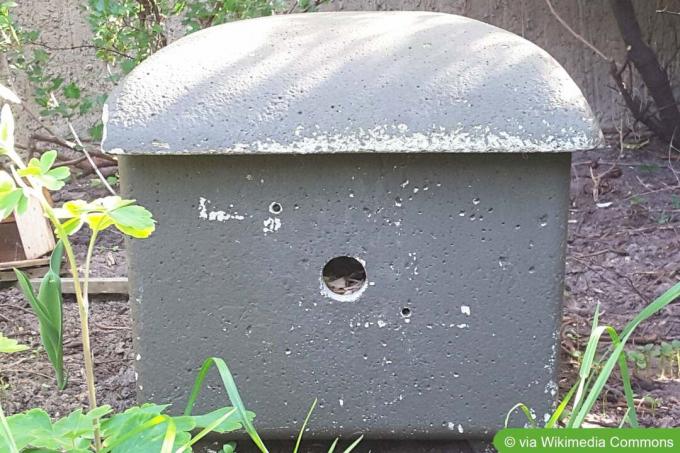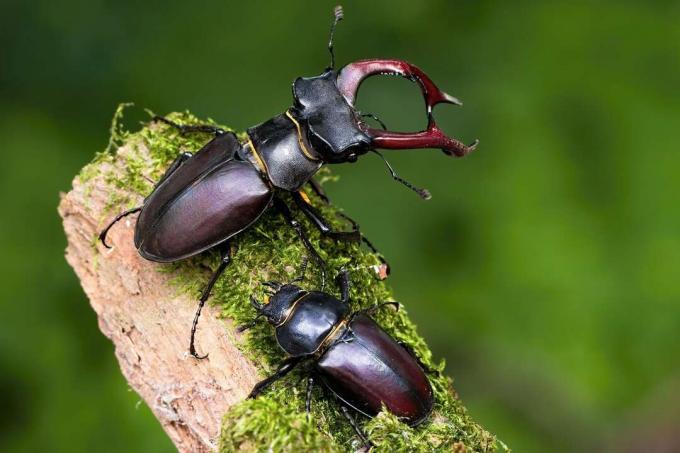

Table of contents
- Build a bumblebee nest box
- Set up the bumblebee box correctly
- Location for the bumblebee nest box
- Have bumblebees settled?
Our bumblebees are threatened with extinction, numerous species are included in the Red List of Threatened Species. If you would like to help conserve these animals that are so important to our natural environment, you could Build a bumblebee nest box so that (perhaps rare) bumblebee offspring can be found in your garden to produce:
Build a bumblebee nest box
For the Building a bumblebee nest box you will need five boards measuring 40 x 40 cm, 2 cm thick, which will form the bottom and side walls. A board of 50 x 50 cm of the same thickness will later become the roof. First, drill a 2.5 cm diameter entry hole about 10 cm above the middle of one of the 40 cm boards in what will later be the front side. A flight board about 5 cm deep and 15 cm wide is glued under this entry hole, which the bumblebees use when taking off and landing. You can either use a piece of leftover wood or a cardboard box like the packaging for toothpaste.
In two of the 40 cm boards, drill at least five holes of 1.5 to 2 cm in diameter for ventilation, 2 cm below the top edge, which are then sealed with gauze or gauze. Now the bottom can be connected to the side parts with wood screws (gauze inside), then the back wall and the front are screwed on.
Set up the bumblebee box correctly
The box is then filled with small animal litter from the drugstore up to a few centimeters below the entrance hole. Now the other equipment can be brought in. For this you need a box of about 20 x 20 cm and 20 cm high, it could also be a little larger, e.g. B. a tall shoe box. A large hole is cut in the front of this box, then place this box in the bumblebee box. The entrance hole must point to the hole in the box, litter is now also filled into the box. In the front center of the box, create a nesting hole in which a nest of padding wool is placed. You can get upholstery wool from upholstery shops, it must be untreated.
To do this, tear up a handful of padding wool, form a cavity in it and place this nest where the bumblebees arrive in the carton from the entry hole. The entrance hole is then connected to the nest in the box with a walkway. This can e.g. B. be made from a toilet paper roll cut in half lengthways, the connection should be inclined downwards from the entrance hole into the nesting trough. You can control this by piling up the litter under the box to a correspondingly high level. Your goal is to offer the queen bumblebee such an inviting nest that she will immediately decide on your bumblebee nesting box and walk straight through the entrance hole to the nest.
Therefore, the tips that the bumblebee nesting box should be painted waterproof because it is set up outdoors should also be viewed critically. Because that could only be done with a paint or with a wood oil that does not disturb the bumblebee's sense of smell. Since bumblebees use smell to detect nectar, among other things, over long distances, their sense of smell is certainly very well developed. Many Hummel friends therefore limit themselves to including the roof board at the top roofing felt cover and hope that the roof overhang will keep the interior from getting soaked. The lid is simply put on, it could be stabilized by a surrounding frame of small strips, which have the outer edges of the lower box as the inside dimensions.
Location for the bumblebee nest box
You now have to find a location for this bumblebee nest box that makes it likely that a queen will settle there. In nature, most bumblebee species nest in abandoned nests of smaller mammals, only the tree bumblebee sticks to tree cavities. Your nest box now imitates such a small mammal nest, so it should be set up accordingly: In an environment that is at least partially shaded and always has a constant temperature and humidity becomes. The box can be warmed up by the morning sun, but should then not be able to heat up further, no mouse would build its nest in sweltering heat. You should also have good access to the bumblebee nest box, you want to check whether something is happening.
Have bumblebees settled?
If you put the box up early in the spring and a passing queen bumblebee found it, she may accept it. Your chances increase the more attractive the bumblebee nest box is for the queen, e.g. B. could you build her a small ramp to the entrance hole with a sloping board. The more similar the interior design is to a mouse's nest, the more comfortable the queen will feel, that's a good thing i.e. if you have some damp moss and ideally the remains of a mouse nest in addition to padding wool bring in
If you don't want to wait and see whether a bumblebee queen will take pity on your nest box, you could also actively settle the bumblebees. In some federal states you need the approval of the responsible nature conservation authority, since you have to catch the bumblebees for a short time. Then in the spring you would have to find a young queen bumblebee who is looking for a nesting place, catch her and put her in the nest box. If you want to capture a queen bumblebee and place it in a bumblebee nest box, there is a specific process you need to follow to make it a success.
If the queen has accepted the nest box, she will show this through her behavior if you take effective precautions against If you have met wax moths in the bumblebee nest box, there is nothing standing in the way of a new generation of bumblebees growing up In the way. If your bumblebee nest box didn't please a bumblebee queen, which unfortunately happens quite often, you still can become active for the protection of bumblebees: many people will ask you about the wooden box that you have in your garden stands. If you explain why every time bumblebees should be protected and how much that helps us all, you have already done a lot for bumblebee protection.
 garden editorial
garden editorial I write about everything that interests me in my garden.
Learn more about insects

Identify beetles with pincers: 10 native species
Beetles are impressive insects. There are large and small, dark and dazzlingly colorful species. Some have pincer-like upper jaws for crushing or holding prey. The stag beetle is the largest among them. We present 10 native beetles with pincers.

Insect Hotel Filling: 10 filling materials
An insect hotel in your own garden offers numerous insects artificial shelter, nesting and wintering opportunities. They are more than necessary, because they are disappearing more and more as a result of massive human intervention in nature. They are essential for survival.

What do ladybugs eat and drink?
There isn't just one ladybug. Instead, there are several different species, not all of which eat aphids in the classic way. Some are even pure herbivores. Read here what else ladybugs like as food.

Insect species: which insects are there in Germany?
In Germany there are around 30,000 species of insects in various shapes and colours. Of these, there are some that are better known than others. In this article you will find a large list of native insects that shape the image of the country.

Fight field crickets in the lawn | What do crickets eat?
On warm summer days you can hear the chirping of field crickets. In places, the skittish insects appear in heaps. They dig holes in the lawn and their singing can be distracting. What do these strange insects eat? How do you get rid of them?

Spiders in Germany | Identify 18 species of spiders
Spiders cause disgust and disgust in many people. It often helps to take a closer look at these fascinating eight-legged creatures. Identify species that are common in Germany with us and learn about their appearance and habits.



